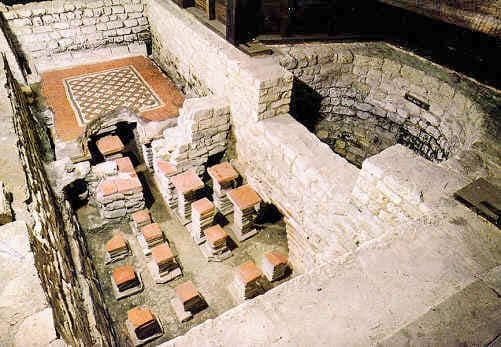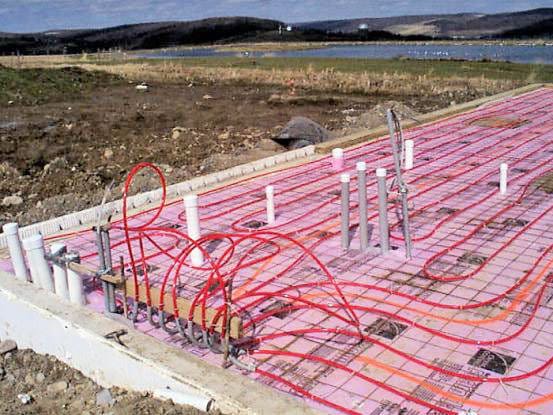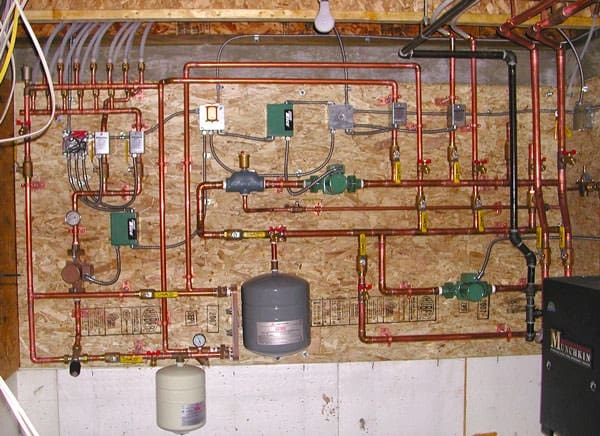
Radiant heating from beneath the floor is a concept as old as the Romans.
Radiant heating systems have been used since the ancient Roman hypocaust. Today, modern radiant heating systems are an increasingly popular method of supplying heat to a barn home. These systems provide steady, gentle warmth to a house by heating a large surface, typically the floor. Although it is possible for a radiant heating system to use panels in the walls or ceiling, these are uncommon in residential construction. Floor-based radiant systems can use almost any common heat source, from solar to gas or fuel oil. Below we discuss the advantages and drawbacks of installing a radiant heating system in your barn home.
Electric and Hydronic Systems
There are two basic types of radiant floor systems: electric and hydronic. Electric systems heat the floor directly from resistive wire in the sub-floor, while a hydronic system uses a remote heat source to heat water which is sent through tubing in the sub-floor. Due to the high cost of electricity as a heat source throughout the country, an electric radiant system is typically only cost-effective to heat the floor of a small room like a bathroom. If you are using electricity to heat the whole house, then a hydronic system, often with a heat pump, will likely be more cost-effective.
 This timber frame home built in Cortland, NY by Timberpeg representative Kevin McMahon went on to receive a Five Star + Energy Star rating.
This timber frame home built in Cortland, NY by Timberpeg representative Kevin McMahon went on to receive a Five Star + Energy Star rating.Since hydronic systems use heated water pumped through the floor to heat the house, they can be driven by most fuel sources. Although fossil-fuel (natural gas, propane, fuel oil, etc.) boilers are the most common systems, renewable sources can be used as well. A solar hot-water system, for example, can be used to supply heat for radiant flooring. The use of a “wet” system, where the heating tubes are run through a layer of concrete below the floor, helps to store heat from a solar heating system. It is also possible to use a “dry” system, where aluminum diffusers and reflectors are used instead of concrete to direct the heat up through the floor. Although “dry” systems are more convenient and cheaper to install, they are less efficient.
Advantages
Radiant heating has a number of advantages over forced-air heating. Radiant heating is more efficient since it does not have duct losses. Since it does not move air around the house, it also won’t distribute dust and allergens around the house like a forced-air system can. Due to the heat rising from the floor upwards, most people are comfortable at a lower air-temperature than with other heating systems, lowering heating costs. Radiant floor systems also leave more humidity in the air than other systems with much higher temperature heating elements. Water in a radiant system is heated to only 100 degrees, approximately. In a baseboard system water is heated to approximately 140 degrees.
Disadvantages
Wood or tile floors, like the wood floors in this Charlottesville, VA barn home great room work best to help the heat radiate into the room.
Radiant heating systems have some disadvantages not present with other heating systems. A “wet” system has a large thermal mass, which makes it difficult to set the temperature back at night or when you are away during the day. Thermostats in radiant systems are usually kept at one temperature. Finally, radiant floor systems work best with tile or wood floors. Carpeted rooms should be minimized; if a room needs to be carpeted make sure to use thin carpets with thin, dense padding. But, since hard floors are such a popular and classic choice, avoiding carpeted rooms is not too big of an obstacle. And the benefits of such an efficient heating system are numerous. If you’d like to learn more about how your barn home can incorporate an in-floor radiant heating system, please contact Timberpeg®.



